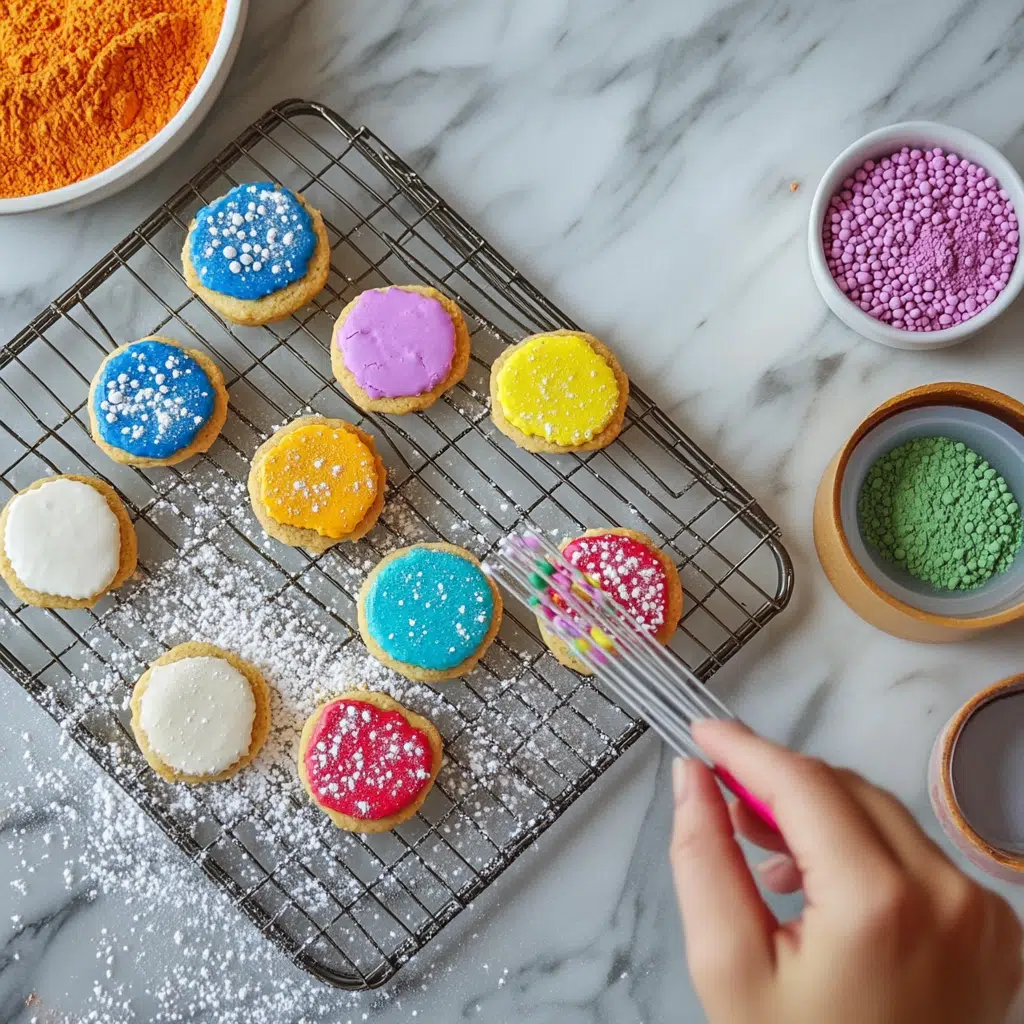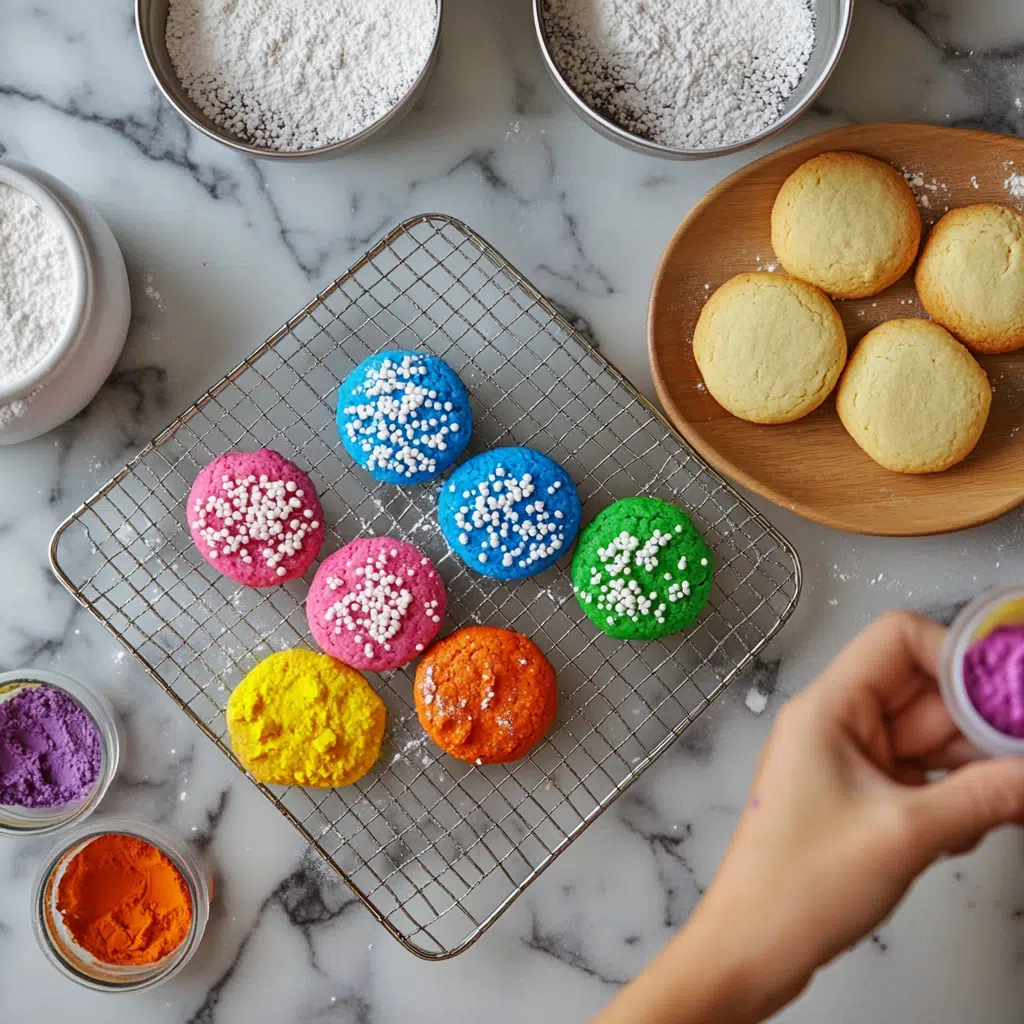Introduction to Cookie Coloring

Adding vibrant colors to cookies is a delightful way to bring creativity and personality to your baking. Whether you’re preparing treats for a festive celebration, personalizing gifts, or simply indulging in a fun activity, cookie coloring elevates your cookies from delicious to dazzling. The practice of coloring cookies has become a hallmark of artistic baking, offering endless possibilities for self-expression. So, How Do You Make Cookie Color?
The Importance of Cookie Color in Baking
The color of cookies plays a significant role in their appeal. Here’s why it matters:
- Visual Impact: A colorful plate of cookies catches the eye and draws attention, making it perfect for parties and special occasions.
- Customization: With cookie coloring, bakers can match cookies to themes, holidays, or personal preferences, adding a unique touch to their creations.
- Creative Outlet: It allows bakers of all skill levels to experiment with patterns, shades, and techniques, turning each cookie into a miniature piece of art.
A well-colored cookie is not just a treat; it becomes an experience that combines taste and visual delight.
A Brief History of Cookie Decorating
The art of decorating cookies dates back centuries, with roots in different cultures worldwide:
- Medieval Europe: Decorated gingerbread cookies were a staple during holidays and festivals, often shaped into intricate patterns.
- 18th Century: The use of sugar icing became widespread, allowing bakers to add delicate details to their creations.
- Modern Techniques: Advances in food coloring and decorating tools have made cookie art more accessible and versatile than ever.
Today, cookie coloring combines traditional methods with innovative techniques, enabling bakers to craft stunning and edible masterpieces.
If you’re eager to learn the basics of food coloring, check out this resource on how to add food coloring to cookies.
Why Should You Make cookie Color?
Colored cookies are an easy way to make any event or gathering memorable. Here’s why people love adding colors to their cookies:

- Aesthetic Appeal: A plate of vibrant cookies is always eye-catching and can be customized to match any theme or occasion.
- Personalized Designs: Adding color allows you to create personalized patterns, names, or decorations on cookies for a special touch.
- Fun for Kids and Adults: Coloring cookies is a fantastic activity for all ages, making it a fun baking project to enjoy with family or friends.
If you’re curious about creating bold and creative cookie styles, explore what rainbow cookies are made from for inspiration.
Methods to Make Cookie Color
1. Coloring Cookie Dough
This technique involves adding color to the dough itself before baking. It’s the best way to achieve even, vibrant colors that shine through after baking.
Step-by-Step Process
- Divide the Dough: Start by dividing your dough into equal portions based on the number of colors you want.
- Add Gel Food Coloring: Add a small amount of gel food coloring to each dough portion. Gel coloring is ideal because it provides intense color without altering the dough’s texture.
- Mix Thoroughly: Knead the dough until the color is evenly distributed. Use gloves to avoid staining your hands.
- Experiment with Effects:
- Marbled Dough: Swirl two or more colors gently to create a beautiful marbled effect.
- Layered Colors: Layer different colored doughs and roll them out for a striped look.
Tips for Success
- Always start with a small amount of color and add more as needed.
- Refrigerate the dough for 15–30 minutes after coloring to make it easier to work with.
Check out this detailed guide on how to add food coloring to cookies for additional tips.
2. Painting on Baked Cookies
Painting is a versatile method that lets you add intricate designs to already baked cookies. It’s ideal for those who want to create unique patterns, names, or themes.
Tools You’ll Need to
- Food-safe paintbrushes of various sizes
- Gel or powder food coloring
- A clear alcohol-based extract (like lemon extract) for mixing colors
Step-by-Step Process
- Prepare the Cookies: Apply a base layer of royal icing to the cookies and allow it to dry completely (at least 6 hours).
- Mix Your Colors: Combine gel food coloring with a few drops of clear extract to create a paint-like consistency.
- Start Painting: Use brushes to apply the colors. Freehand designs, stencils, or stamps can be used for precision.
- Drying Time: Allow painted cookies to dry completely before packaging or stacking.
Creative Design Ideas
- Ombre Patterns: Blend shades from light to dark for a gradient effect.
- Floral Designs: Use fine-tipped brushes to paint flowers and leaves.
- Abstract Art: Experiment with splatter techniques or freehand designs.
Learn more techniques with this step-by-step painting guide.
Tips for Vibrant Cookie Colors
Achieving bright and beautiful cookie colors requires attention to detail. Here are some tips to help you succeed:
- Choose the Right Food Coloring: Use gel food coloring for vibrant shades or natural dyes like beetroot or spirulina for a softer, earthy palette.
- Control the Dough Consistency: If the dough becomes sticky after adding color, refrigerate it for 15 minutes.
- Monitor Baking Conditions: Over-baking can dull the colors. Follow the recipe’s baking time closely to maintain vibrant shades.
- Layer for Depth: If using painting techniques, allow each color to dry before applying the next for crisp lines and vibrant layers.
For colorful ingredient ideas and recipes, check out colorful ingredients in cookie recipes.
Common Mistakes and How to Avoid Them
Even experienced bakers can encounter challenges when it comes to coloring cookies. Understanding these common mistakes and how to address them ensures your cookies turn out vibrant and flawless every time.
Overmixing and Its Impact on Color and Texture
Overmixing is a frequent issue when adding color to cookie dough, and it can negatively affect both the appearance and texture of your cookies.
- Impact on Color: Overmixing can cause the colors to become dull or uneven, especially if you’re working with marbled or layered designs. It can also introduce air bubbles, leading to inconsistent shading.
- Impact on Texture: Overworked dough becomes tough, losing the soft and tender texture that cookies should have.
How to Avoid It:
- Add food coloring to the wet ingredients (like eggs) before combining them with the dry ingredients for easier distribution.
- Mix the dough just until the color is evenly incorporated, avoiding excess handling.
- Chill the dough if it becomes sticky or difficult to work with.
Preventing Color Bleeding During Application
Color bleeding is a common problem, particularly when painting cookies or layering icing. It occurs when one color seeps into another, disrupting the clarity of your designs.
Causes:
- Using excessively wet icing or paint mixtures.
- Not allowing adequate drying time between layers.
- High humidity or improper storage.
How to Avoid It:
- Ensure each layer of icing or paint is completely dry before applying the next. This can take several hours or even overnight for royal icing.
- Use gel or powder food coloring mixed with minimal liquid for better control.
- Store decorated cookies in a cool, dry place to maintain their integrity.
By following these tips, you can achieve vibrant, clean designs without the frustration of colors running together. Paying attention to these details ensures your cookies are not just visually stunning but a true testament to your baking skills.
Troubleshooting Common Problems
Even experienced bakers may face challenges when coloring cookies. Here’s how to address common issues:
- Uneven Coloring in Dough: Mix the coloring with wet ingredients like eggs before combining it with the dough.
- Bleeding Colors in Painted Cookies: Ensure each layer of paint or icing is dry before adding the next.
- Sticky Dough: Dust the dough lightly with flour or chill it for a firmer texture.
- Faded Colors After Baking: Use concentrated gel food coloring and avoid overbaking.
FAQs About Coloring Cookies
How to Make Cookie Color?
Making cookie color starts with choosing the right method and tools. The two most popular approaches are:
- Coloring the Dough
Add gel food coloring to cookie dough before baking. Divide the dough into portions, mix in your desired colors, and knead thoroughly to ensure even coloring. If you’re unsure how to get started, explore these colorful cookie ingredient ideas. - Painting on Cookies
Apply a base layer of royal icing to baked cookies and let it dry completely. Mix food coloring with lemon extract or alcohol-based clear vanilla and paint directly onto the cookies using food-safe brushes. Learn more about cookie painting in this guide on colorful baking.
How Do You Make Cookie Color Paint?
Creating cookie color paint is easy with the right materials. Here’s a quick guide:
- Ingredients Needed:
- Gel or powder food coloring
- Lemon extract or clear alcohol-based extract (e.g., vodka)
- Mixing Process:
- Add a few drops of food coloring to a small bowl.
- Gradually mix in the extract until you achieve a paint-like consistency.
- Test the color on a scrap of dried royal icing to ensure the desired effect.
This method produces vibrant, paintable colors that dry quickly. For intricate designs, consider using stencils or fine-tipped brushes.
How to Make Cookie Brown Color?
Creating brown cookie color is straightforward, and you can achieve it using either artificial food coloring or natural methods:
- Using Food Coloring:
- Mix red, yellow, and blue gel colors in equal parts. Adjust the ratios to create lighter or darker shades of brown.
- Natural Options:
- Use cocoa powder for a rich, chocolatey brown.
- Brewed coffee or espresso can add both flavor and a subtle brown hue to the dough.
For cookies requiring a deeper brown tone, explore how to use colorful and natural ingredients in recipes.
What Food Coloring is Best for Cookies?
The best food coloring for cookies depends on the desired effect and method:
- Gel Food Coloring: Highly concentrated, perfect for vibrant hues in dough and icing.
- Powder Food Coloring: Great for subtle or pastel tones without altering the dough’s texture.
- Natural Food Coloring: Made from plant-based ingredients like beetroot or spirulina for softer, organic shades.
For baked cookies with intricate designs, gel coloring mixed with an alcohol-based extract works best for painting. Need more inspiration? Learn about what rainbow cookies are made from.
How Do You Color Cookies Naturally?
To color cookies naturally, use plant-based or organic ingredients. Here are some popular options:
- Beet Juice: Produces vibrant pinks and reds.
- Spinach or Matcha Powder: Ideal for green shades.
- Turmeric: Adds warm yellow tones.
- Cocoa Powder: Perfect for brown or chocolate hues.
- Blueberries: Blended and strained, they provide purple or blue tones.
Natural colors often result in muted shades but are a healthier alternative. For more ideas, check out this guide on using colorful ingredients.
What is a Color of a Cookie?
The natural color of a cookie depends on its ingredients:
- Uncolored Cookies: Typically golden brown due to the Maillard reaction during baking.
- Chocolate Cookies: Dark brown from cocoa or chocolate.
- Frosted or Painted Cookies: Take on any shade based on the chosen decoration or food coloring.
To create cookies with vibrant, personalized colors, explore methods like dough coloring or painting as described in this cookie coloring guide.
Conclusion: Mastering Cookie Color
Mastering the art of cookie coloring opens up a world of creativity and personalization in baking. Whether you’re adding vibrant shades to dough, painting intricate designs on baked cookies, or experimenting with natural food dyes, the possibilities are as limitless as your imagination.
By understanding the right techniques, using high-quality materials, and avoiding common pitfalls like overmixing or color bleeding, you can elevate your cookies into edible works of art. Remember, the key to success lies in practice and a willingness to explore new ideas.
So, gather your tools, choose your favorite colors, and start creating cookies that are not only delicious but visually enchanting. Your journey into the colorful world of cookie art is just beginning—enjoy every moment of it!
Ready to get started? Discover more creative options for vibrant baking at what rainbow cookies are made from. Happy baking!

